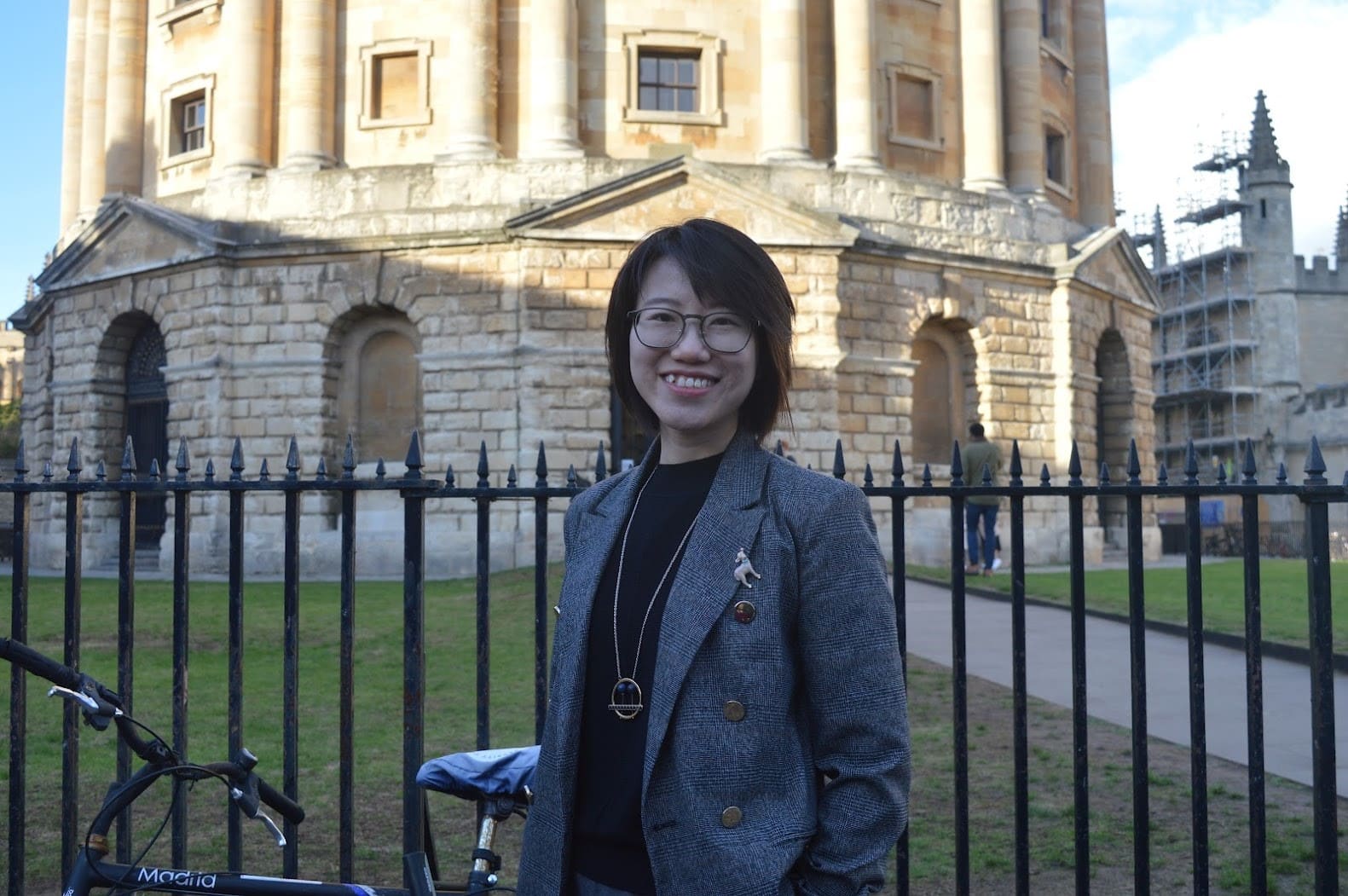How can origami help make energy?
Wednesday 19th Jun 2024, 12.30pm
Discover how the ancient art of origami is revolutionising sustainable energy!
Researcher Jingyi Yang, from the Department of Engineering Science, has loved origami since childhood. Now she’s channelling that passion to tackle engineering challenges. Using the intricate papercraft to develop clam-like models, Jinyi’s creative engineering may be the key to improving the efficiency of energy produced by the waves hitting the UK’s coastline.
Find out more about this imaginative approach to scientific discovery in this podcast!
Emily Elias: Waves from the ocean hitting the shore generate a lot of power, and there are even wave generators out there to harvest it. But what if we could make them more efficiently?
Some researchers at the University of Oxford believe that origami could be the key to unlocking this, and so on this episode of the Oxford Sparks Big Questions Podcast, we’re asking, how can origami help make energy?
Hello, I’m Emily Elias, and this is the show where we seek out the brightest minds at the University of Oxford, and we ask them the big questions. And for this one, we have found a researcher who is great at folding and unfolding things.
Jingyi Yang: My name is Jingyi Yang. I’m a postdoc researcher at University of Oxford. I’m working in Department of Engineering Science, working on origami inspired deployable structures.
Emily: Okay, so origami. I mean, where did your love for origami first begin?
Jingyi: Well, yeah, it’s been a long time. When I was four or five years old, my grandma taught me how to fold those paper frocks. procone darts, and also the fortune tellers. You know, it’s really fun. I can stay there and play for many hours out of it. I don’t know why did I do that. But, yeah, since a young girl, I’ve been interested in origami.
And then later on, I found a Professor in Oxford working origami inspired engineering.
So it’s a perfect match for me.
Emily: How do engineering and origami come together?
Jingyi: Okay, so people believe that origami was originated in China because the Chinese invented paper. And then the paper folding technique is popularised in Japan. And initially, people used that for decorations for religious ceremonies, etc, for recreation of children. Until 1960s, mathematician and origamist called Akira
Yoshizawa, he wrote many books about the fundamental mathematics about origami. And that’s why origami becomes more popular and spread to the western world.
Since then, people have been working on origami inspired engineering. Especially there is a very famous American, he used to be a NASA engineer. The name of him is Robert Lang. And he’s also interested in origami. And he thought, why cannot I just use origami to fold solar panels of satellites? And, that is the start of origami inspired engineer.
So because it is the origami, we fold a piece of paper from flat state into some very interesting geometries, such as a play, a pagondi, etc. But it can go beyond that. So in engineering, we use that property to fold something from a flat sheet into a very compact volume. For example, we can fold solar panels of satellite or reflect array antennas. They all need to be really a flat sheet, continuous surface folded into a very compact volume, put inside of the rocket before launching and then pull, expand it to a flat and continued surface when it is in orbit.
Emily: So is it just for like, okay, so we’ve got to make something compact and fold out when we’re putting it into space. Or can it be used in other ways?
Jingyi: Oh, yes, there are many applications of origami. So for example, we are working on some endovascular stent.
Emily: What is that?
Jingyi: So people, when people getting older, or they’re not living in a great healthy lifestyle. So, the blood vessel may get blocked. Surgeons need to put a little stent inside of the vessel to expand it to clear the blockage. And one of the way to do that is to make a little cut either at the hand or at the leg. And it goes together with a catheter, a blue catheter, folding from a really small size and then pump open to clear the blockage at a blocked area.
Emily: So from a medical standpoint, you can use it to get something in a tiny space that can then expand out and do its job.
Jingyi: Exactly. It’s a medical device.
Emily: What about energy? Like, what exactly are you working on?
Jingyi: Okay, in my D.Phil, I was working on the thing that I talked to you just now.
Foldable satellite or foldable reflect array antennas.
Moving on to my postdoc position, I’m working on a wave energy converter. So it is an origami inspired wave energy converter. Because it’s the UK, we have a lot of coastlines, we want to utilise those free energy or sustainable energy, let’s put it this way. And then we want to put one metre size or 50 metre size wave energy converters floating inside of the sea to harvest the energy, converting the wave motion to electricity.
Emily: Okay, so these are the things that are like just hanging out on the edges of the coast and they’re passively getting like, rocked around and then we’re getting energy off of them.
Jingyi: Exactly. So they are anchored to the seabed and then they are floating and they are opens and close, breathing air and breathing out of air, to generate energy.
Emily: So how do you go about designing something like that using origami as a technique? Do you literally sit there and fold a piece of paper of what you think the structure could look like and do?
Jingyi: Yeah, exactly. So that is exactly what this seems like for my daily job. Yeah. Instead of reading a paper, folding paper seems easier, isn’t it? So, I actually want to show you my office. I actually have a lot of scrapped paper. What we like to do is because nature finds its own way to the minimal energy state. And then we can find a crease pattern, which is the fold pattern for the origami. And that is the natural way that the structure would like to be. So, yeah, so from there we do some optimization work, mathematical work, to prove, okay, this is the really lowest energy state that the structure would like to stay.
Emily: So you’re looking at nature for inspiration to then make your origami. In the case of trying to figure out something that like, will use the power of waves in the ocean.
What have you taken inspiration from on this project?
Jingyi: Oh, it’s actually a sea clam. So it is the clam that we usually eat on dining table. So it opens and closes, opens and closes. For the clam itself, it is not enclosed. However, in our case, we need to make a fully enclosed body in order for it to survive the ocean condition because we don’t want water to trap inside of the expensive machineries.
Emily: So do you have like 1000 paper clams that you like folded and refolded to try and find the right configuration?
Jingyi: We did have a lot of trial and error in the beginning of the project. And yeah, we have a lot of configurations. You’re right, exactly. And then probably after eight months, we kind of fixed a configuration. And then we start to optimise the configuration to make it have less strain, have to have more power takeoff, etc.
Emily: So what does it look like?
Jingyi: Well, I really want to show you. So it is like a clam. It’s like a sea clam with two rigid plates. They cut flap and then some origami pleats in the middle to facilitate the connection and to facilitate the motion of it. So it has to be a fully enclosed body in order for it to survive in seawater. We don’t want any seawater to trap inside. So it is like a, it is like a bellow or it is like accordion. So if you can see the pleats, if you can imagine the pleats in between of the two rigid plate, it is just like a bellow. In the old days, you use the bellow to light up a fire, to have barbecue. It is just like a bellow case.
Emily: Oh, so like an accordion. So you push it in and you pull it out.
Jingyi: Exactly. So the wave motion will do the pushing in and out in terms of wave crest and wave troughs. And then the motion is generated by the sea and then it all dance by itself.
Emily: Is it out in the wild working or is it still in the lab?
Jingyi: It is still in the lab. So we are trying to do a proof concept project over here. And then we make some desktop models. We make some downscaled models for the tank test. Well, the plan is the tank test will be completed in the summer in University of Plymouth, which is our collaborator.
Emily: And what has to happen for it to pass the tank test?
Jingyi: First of all, we are having a lot of electronics and controls motors inside of these origami clams, so that we call this wave energy converter. So, first of all, we try to simulate the wave motion and to replicate the wave motion using the control system, the motors, etcetera. first of all, it can’t be sinking. It needs to be floating up there. And secondly, it needs to have a great swept angle as we designed or imagined for the machinery for it to generate electricity. Meanwhile, we are doing some dry tests as well. So not inside of the ocean basin, but on the ground, trying to see the range of motion of the origami, fully enclosed origami wave energy converter, and to see what is the strain and stress.
Emily: So how is it going so far?
Jingyi: it went pretty well, a bit delayed due to the COVID but we are trying to perform the tank test and dread test probably next month.
Emily: Are you feeling anxious about it?
Jingyi: Well, I’m excited about it, to be honest. I’m very excited to see, the wave energy converter putting into the water and to see how it behaves.
Emily: What do you think this could mean further down the line? If we’re able to use origami to harness the power of the sea, what could that mean for our planet?
Jingyi: So currently there are also some wave energy converter, but the cost is really huge. By using origami wave energy converter, we try to reduce down the cost which means we can have many of them put it inside of the water to harvest energy. And the ocean energy is purely sustainable energies. It is free. That’s why if we can harness that, it’s just another source of energy apart from wind, apart from solar, and probably apart from fusion efficient, if that is, coming soon, that is a step towards the net zero nation.
Emily: The UK has a lot of coastlines, so this could be a big game changer, right?
Jingyi: I believe so. And I’m really, that’s why I’m really excited about it.
Emily: This podcast was brought to you by Oxford Sparks from the University of Oxford with music by John Lyons and a special thanks to Jingyi Yang.
Tell us what you think about this podcast. We are on the internet @OxfordSparks and pitch us your big question and we will find you a big answer. Our website is also out there, oxfordsparks.ox.ac.uk. I’m Emily Elias. Bye for nowhere.




